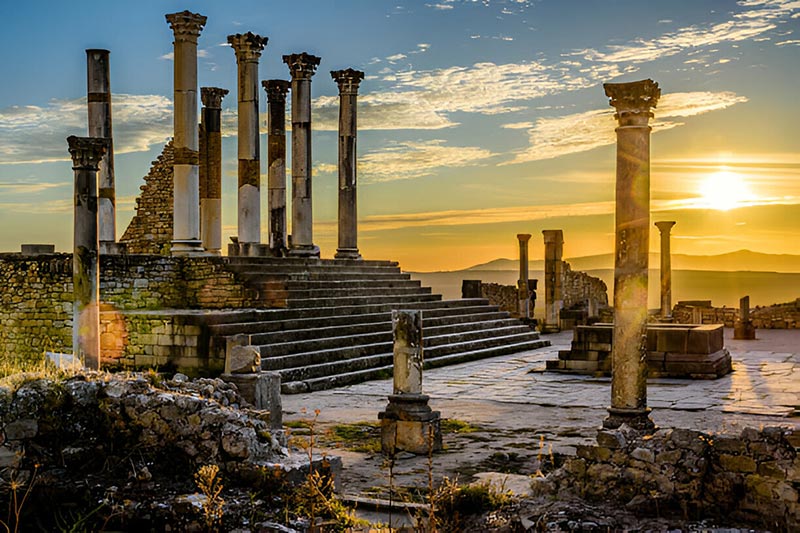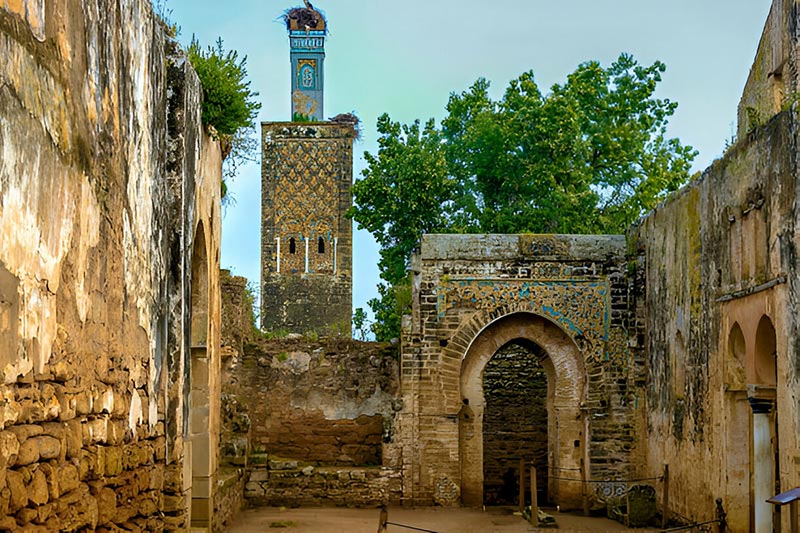Morocco is a land of rich history and culture. Among its many treasures are the ancient cities that tell the story of the past. These cities were once bustling centers of trade, learning, and life. Today, they stand as fascinating ruins, waiting to be explored.
In this article, we will go through five of Morocco’s most significant ancient cities. We will visit Volubilis, an impressive Roman site. We will explore Lixus, a city with Phoenician roots. We’ll uncover the mysteries of Sala Colonia – Chellah, a blend of Roman and Islamic history. We will admire Aït-ben-Haddou, a stunning fortified village. Lastly, we will discover the Phoenician Tombs, ancient resting places with deep history.
Each city has its own unique story. They offer a glimpse into different periods of Morocco’s past. By visiting these sites, you can walk through history and see the remnants of ancient civilizations. Our journey will begin with Volubilis, the grand Roman city.
Volubilis

Volubilis is a grand ancient city in Morocco. It was built by the Romans nearly 2,000 years ago. This city was once a bustling center of trade and government. The Romans chose Volubilis because of its fertile land and strategic location. They built many beautiful buildings and structures. Volubilis became a very important city in the Roman Empire.
The architecture of Volubilis is truly amazing. The city is famous for its beautiful mosaics. These colorful artworks decorate the floors of many buildings. There are also grand arches and impressive columns. One of the most famous structures is the Triumphal Arch. This arch is a large, stone monument that was built to celebrate a military victory. There are also many well-preserved houses, baths, and temples.
Volubilis is not just a city of ruins; it’s a place full of stories. The city shows us how people lived long ago. It tells us about their culture, their daily life, and their beliefs. The mosaics, for example, often show scenes from myths and legends. The public baths and market areas tell us about the social life of the people. Volubilis helps us understand more about the Roman world.
Visiting Volubilis is like stepping back in time. The site is located near the town of Meknes. It is easy to reach by car or bus. When you visit, wear comfortable shoes because you will walk a lot. The best time to visit is in the morning when it is cooler. Don’t forget to bring a hat and water. There are guided tours available that can help you learn more about the history and importance of this amazing place.
Lixus
Lixus is one of the oldest cities in Morocco. It was first settled by the Phoenicians around 3,000 years ago. Later, it became a part of the Roman Empire. Lixus was a busy port and a center for trade. The city grew because it was located near the river, making it easy for ships to come and go. The Romans expanded the city and built many new structures.
The ruins of Lixus are fascinating to explore. One of the main attractions is the large amphitheater. This was a place where people watched games and shows. There are also ancient baths, where people would relax and socialize. Many artifacts, like pottery and tools, have been found here. These items help us learn about the daily life of the people who lived in Lixus.
Lixus was an important cultural center in ancient times. The city was known for its fish salting industry. This industry was very valuable and brought wealth to the city. The mixture of Phoenician and Roman influences can be seen in the ruins and artifacts. Lixus tells the story of a city that was a melting pot of different cultures and traditions.
Visiting Lixus is an exciting adventure. The site is located near the town of Larache. It’s easy to get there by car or taxi. Wear comfortable shoes because the site is large and there is a lot to see. Bring a hat and water, especially if you visit during the summer. There are information boards around the site that explain the history and significance of the ruins.
Sala Colonia – Chellah
Sala Colonia, also known as Chellah, has a rich history. It was first settled by the Romans. They built a town with strong walls and many buildings. Later, it was taken over by the Islamic Merinid dynasty. The Merinids turned it into a beautiful necropolis or burial ground. This site shows a unique mix of Roman and Islamic influences.
Sala Colonia-Chellah has a fascinating blend of architecture.
- Roman Ruins: The Roman part includes baths, a forum, and a triumphal arch. These ruins show the grand style of Roman buildings.
- Merinid Necropolis: The Merinid section has tombs, gardens, and a mosque. These structures are decorated with beautiful tiles and carvings.
Chellah is important because it tells the story of two different cultures. The site is peaceful, with gardens and birds. Visitors can see storks nesting on the ancient walls. The mix of ruins and nature makes Chellah a special place. It is a perfect spot to learn about history and enjoy the beauty of the surroundings.
To visit Chellah, you can travel to Rabat, the capital city of Morocco. It is easy to reach by bus or taxi. Wear good walking shoes and bring water, as you will be outside. The best time to visit is in the morning or late afternoon when it is cooler. There are signs around the site that tell you about its history. Guided tours are also available to help you learn more.

Aït-ben-Haddou
Aït-ben-Haddou is a famous fortified village in Morocco. It was built hundreds of years ago along the old caravan routes. Traders would stop here to rest and do business. The village is made of mud bricks and is surrounded by high walls. It has been well-preserved and looks much like it did in ancient times.
The architecture of Aït-ben-Haddou is very unique. The village is made up of many kasbahs, which are tall houses built close together. These houses have thick walls to keep them cool in the hot desert sun. The roofs are flat and often used for drying crops. The village looks like a castle from a fairy tale, with its towers and narrow streets.
Aït-ben-Haddou is not just an old village; it is still important today. It is a UNESCO World Heritage site because of its historical value. Many movies and TV shows have been filmed here because of its beauty. Visitors come from all over the world to see the village and learn about its history. It helps people understand how life was in ancient times.
Visiting Aït-ben-Haddou is an exciting experience. The village is located near the city of Ouarzazate. You can get there by car or bus. Wear comfortable shoes for walking on the uneven paths. Bring water and a hat to stay cool. There are shops and cafes where you can buy souvenirs and refreshments. You can also hire a local guide to show you around and tell you more about the village’s history.
Phoenician Tombs
The Phoenician Tombs are very old burial sites in Morocco. The Phoenicians were ancient sailors and traders who lived around 3,000 years ago. They traveled across the Mediterranean Sea and set up colonies in different places, including Morocco. These tombs show us where they buried their dead and how they honored them.
Many interesting artifacts have been found in the Phoenician Tombs. These include pottery, jewelry, and tools. These items tell us about the daily lives of the Phoenicians. The tombs themselves are made of stone and are often decorated with carvings. These discoveries help us learn more about this ancient civilization.
The Phoenician Tombs are important because they show the influence of the Phoenicians in Morocco. They traded goods and ideas with the local people. This exchange helped shape the culture of the region. The tombs are a reminder of this connection and the lasting impact of the Phoenicians.
Visiting the Phoenician Tombs is a great way to explore ancient history. The tombs are located near the coast, close to the city of Tangier. You can get there by car or taxi. Wear comfortable shoes for walking around the site. Bring a hat and water, especially on hot days. There are signs that explain the history of the tombs. You can also join a guided tour to learn even more.
Conclusion
Morocco’s ancient cities are like open history books, each page revealing a unique story of the past. Volubilis, with its grand Roman ruins and stunning mosaics, offers a glimpse into the life of a bustling Roman city. Lixus, with its Phoenician and Roman roots, shows the rich blend of cultures and the importance of trade in ancient times. Sala Colonia – Chellah, a peaceful site blending Roman and Islamic architecture, illustrates the layers of history that have shaped Morocco.
Aït-ben-Haddou stands as a striking example of traditional Moroccan architecture, its mud-brick kasbahs a testament to the ingenuity and resilience of its builders. Finally, the Phoenician Tombs near Tangier provide a deep connection to one of the ancient world’s great seafaring civilizations, revealing their customs and the long-lasting impact of their presence in Morocco.
These ancient cities not only tell us about the past but also enrich our understanding of the present. They show how different cultures have influenced and shaped the region. Visiting these sites is like traveling back in time, offering a chance to walk through history and experience the grandeur of ancient civilizations.
Exploring Morocco’s ancient cities is an adventure filled with discovery and wonder. Each site offers unique insights and experiences, making them must-visit destinations for history lovers and curious travelers alike. Plan your trip to these historical gems and uncover the fascinating stories of Morocco’s rich heritage.
